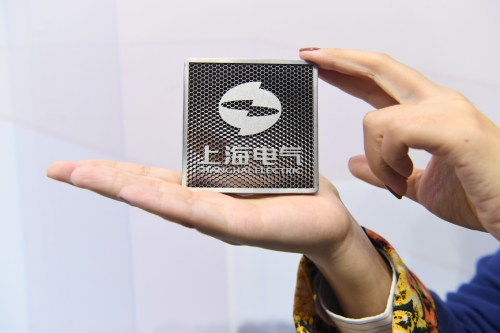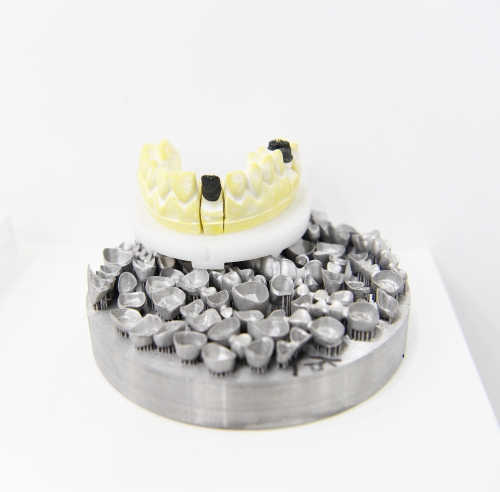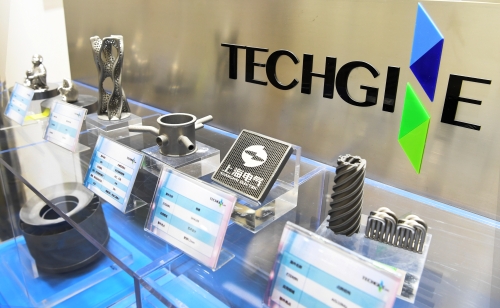3D printing represents the third industrial revolution, which will be defined by its applications to digitalization, AI manufacturing, and new materials.
—The Economist, U.K.
In the long history of humankind, there have been two previous industrial revolutions. The first revolution was the steam engine and the second was electricity. The former gave us movement, and the latter gave us light. The Economist's comparison of 3D printing to these two technologies reveals the high expectations that exist for the technology.
Today, 3D printing concepts are receiving widespread attention in academia and industry. Over the past few years, the technology has reached a transitional phase, but its first true flowering is just around the corner.
1
Shanghai Techgine: a dark horse on a 3D printing journey
At the end of February, 2019 TCT Asia, an annual additive manufacturing industry event, opened in Shanghai. Over 300 leaders in the additive manufacturing industry exhibited their technologies. Shanghai Techgine Laser Technology Co., Ltd. attended to promote the latest products in its series - the TZ-SLM500A, TZ-SLM300A and TZ-SLM120. Precise, stable and efficient, each one of the three differently-sized products has its own focus and target industry, and drew admiring crowds to the Techgine stand.
Techgine is a forward-thinking company in the field of 3D metal printing. It owns proprietary technologies which can produce some of the most advanced metal pieces in China. Backed by Shanghai Electric and Huazhong University of Science and Technology, Techgine is highly competitive in the 3D metal printing sector.
Focusing on 3D metal printing
The printing of metal pieces using laser additive manufacturing technology is also called 3D printing. A common 3D printing technique is selective laser melting (SLM). Zeng Xiaoyan, a professor at Huazhong University of Science and Technology, and his team first produced an SLM installation in 2007. This machine made Shanghai Electric start paying attention to 3D metal printing and Zeng's team. This led to Shanghai Electric signing a framework agreement with Huazhong University of Science and Technology in December 2015.
In March 2016, Shanghai Techgine Laser Technology Co., Ltd. ("Techgine") was registered and established. In September 2016, Techgine moved into a new plant dedicated to the research, development, manufacture and sale of 3D metal printing machines and related technical services, including professional 3D metal printing services for industrial applications. While Techgine mainly focused on the industrial sector, there was also demand from the general public, and even efforts to use the technology in arts and crafts.
With Techgine's establishment, Zeng's SLM technology continued to overcome new challenges. The Shanghai Electric team provided advanced lasers and industry leading package assembly capabilities, which allowed Zeng and other professors to put their technical achievements into practice. Seasoned engineers from the machine-tool industry gradually turned advanced technical research results into commercialized products, taking them from theory and prototype to the first small batch and then mass manufacturing.
Special things happen when industry and academia come together. And for the past two years, the Shanghai Electric and Huazhong University of Science and Technology coalition at Techgine has worked day and night to create new disruptive technologies, iterate the products, and commercialize the results of research.
Three models, three specialties
Techgine is led by the scientists that first researched and developed 3D metal laser printing in China over ten years ago. Now, after many years of work, the results are coming thick and fast. As of today, Techgine has released three series of products. The first generation product used unidirectional powder layering, while the second generation product provided bidirectional powder layering. The third generation product is Techgine's unique patented technology which features four lasers printing up to 50*50*100 cm in size. It is the largest 3D printing machine in the selective laser melting industry and represents a huge technical breakthrough.
Techgine's third generation metal laser 3D printers have been built using independently developed intellectual property. They use selective laser melting, also known as laser powder bed fusion. This produces high performance metal pieces without cutting tools or molds.
SLM is one of the most difficult yet widely followed approaches in 3D printing technology. It produces pieces with a high level of precision. The parts perform better than castings and forgings, and complex structures can be formed holistically. The parts can be widely applied in a range of industries.
The development of the technology can be directly observed in the evolution in Techgine's products from first generation to third generation. In this industry, breakthroughs are disruptive. Unidirectional powder layering technology has now been supplanted by bidirectional powder layering. The use of four-laser sweeping guarantees manufacturing efficiency. The TZ-SLM500A can print parts as large as 50*50*100 cm, making it able to satisfy most industrial needs. The model is the first in the world to use four-laser sweeps to manufacture metal parts. This method allows the production of large parts with high precision and at a high deposition rate while guaranteeing part quality.
Quality is everything. The TZ-SLM300A is the result of countless iterations and improvements. A stable and reliable medium-sized workhorse, the machine can produce large batches of complex, structurally precise parts.
Specialization leads to expertise. The TZ-SLM120 was originally designed with false teeth manufacturing and medical implants in mind. Quick and nimble, this printer fits into small spaces to satisfy market need. It is the new generation of printer for dentistry, jewelry, and education.
Structurally-complex parts made of a range of materials and with innumerable industrial applications were on display at TCT Asia, including a 1m long steam turbine blade, a 500mm rocket nozzle, and a 0.2mm thick medical grille, as well as screws, hollow objects, odd pieces and all-in-one parts. Everything imaginable was on display, from rockets bound for the sky to false teeth bound for the human mouth, drawing large crowds to the booth.
In 2017, Shanghai Electric applied to carry out a national key research project on multi-functional wide beam laser additive/detractive compound manufacturing equipment. The project was later approved by the Ministry of Science and Technology, with conclusions expected in four years. Through the project, Techgine is hoping to make breakthroughs in laser additive/detractive compound manufacturing equipment.
Making the world more capable
In traditional manufacturing, there is a value chain that takes the raw material from the supplier to manufacturer to brand/product owner to distributor to retailer and finally to the consumer. Each step in this chain meets the needs of the step that comes after it. In last step, the retailer meets the needs of the consumer. This means that the demand of the consumer cannot be directly transmitted to the producer. However, with the increasing awareness of cloud-based network technologies and concepts, it is now possible for consumer demand to be directly transmitted to the producer, brand owner, or even the raw materials supplier. The widespread adoption of 3D printing can help directly transmit information, thereby directly producing value. This means that each step in the chain can be responsive to the consumer's needs. In the future, it is hoped that a "value network" will emerge to supplement the value chain.
The transformation from a value chain to a value network and from mass manufacturing to customization is an inevitable trend in the current market and technology world. 3D printing technologies are a critical technology for this transformation, with the ability to remake the capacity of the world.
A wide range of industries, from aviation to medicine, can use 3D printing. With selective laser sintering and direct metal laser sintering, 3D printing can meet the needs of a large number of sectors. In 2018, China launched more than 40 rockets into space. With the ever-growing number of launches, the need for quality is increasing. Rockets are made up of a huge number of complex structures, and the turbine pump impeller is one of the most complicated. Therefore, there is a desperate need for new manufacturing techniques and laser additive manufacturing of metal parts is providing one new option.
At present, Techgine can cast materials including titanium alloy, high temperature alloys, aluminum alloy, stainless steel, die steel, and high tensile steel. In laboratory tests, SLM-produced AlSi10Mg and 2xxx-7xxx series aluminum alloy parts and magnesium alloys parts performed better than castings, with applications in aeronautics, astronautics, medical research, and die manufacturing.
Techgine's 3D metal printing products have been applied most to the aeronautics, astronautics and military fields. At present, a large proportion of the equipment used in these fields is made by overseas producers. However, as production capacity increases, Chinese-made equipment with independent intellectual property rights is bound to take up an ever larger share.
Techgine's technologies have been applied most successfully to the fields of aeronautics and astronautics. Techgine's third generation products use four lasers and bidirectional powder layering to create large objects at a rate of up to 75cm3/h. Precision has reached ±5μm, sufficient for materials that are difficult to process, such as high-temperature alloys. 3D printing has significantly improved the efficiency of research and development for researchers in this field.
In addition to aeronautics and astronautics, Techgine has worked in the medical sector with the Shanghai No. 4, No. 5, No. 6 and No. 8 Hospitals and applied its technologies to the automobile, weapons, higher education research institute sectors. Techgine's technologies can also be used for crafts, such as printing jewelry.
Yet to truly arrive, 3D printing requires designers to break out of the shackles of deductive manufacturing. Today, Techgine is gradually providing more premium products and technology support services for higher education institutes, companies and research institutes. A number of well-known Chinese research institutes in aeronautics and astronautics have used Techgine's equipment for more than two years, providing very positive feedback and demonstrating the power of the technology.
Bright outlook for the industry
A annual report published by Wohlers Associates at the end of 2018 revealed that in 2017, sales across the entire 3D printing industry grew by 21%, with 3D metal printing system sales growing even faster at 80%. In 2018, Wohlers Associates published their annual report on the 3D printing industry, revealing that the entire industry grew by 21%, with 3D metal printing system sales growing even faster at 80%.
The 344-page report provided a wealth of information on the additive manufacturing sector. On the whole, the industry is growing rapidly, especially the 3D metal printing sector. In 2016, it is estimated that 983 3D metal printers were sold. This number grew by 80% to 1,768 units in 2017, representing the biggest annual growth since 2000. The numbers are not the only things going up. With the rapid increase in the number of installations of 3D metal printing systems in 2018, there was also concurrent improvement in 3D metal printing techniques. Printing process controls and print quality measures are gradually advancing, although there still remains much work to be done. Overall, the report was very encouraging for the metal additive manufacturing sector and was positive about the take-up of 3D printing in general.
Techgine is the only SLM equipment manufacturer in Shanghai. SLM parts far outperform castings, while their overall performance rating matches that of forgings (with performance in some areas exceeding forgings). This means they can be used in steam turbines and combustion engines. The potential applications are vast.
Ten years of research and development has resulted in extraordinary achievements in manufacturing. TCT Asia is now over, but Techgine's journey has only just begun. As the science continues to develop, Techgine will continue to be driven by forward-thinking technologies with the aim of becoming a household name in global manufacturing. The way is as hard as iron, but we will march on. Techgine may be a dark horse, but it is not afraid to race.
- Previous: Forging ahead to explore the "blue ocean" rehabilitation industry
- Next: no












 Shanghai PNS registry No. 31011502003537
Shanghai PNS registry No. 31011502003537